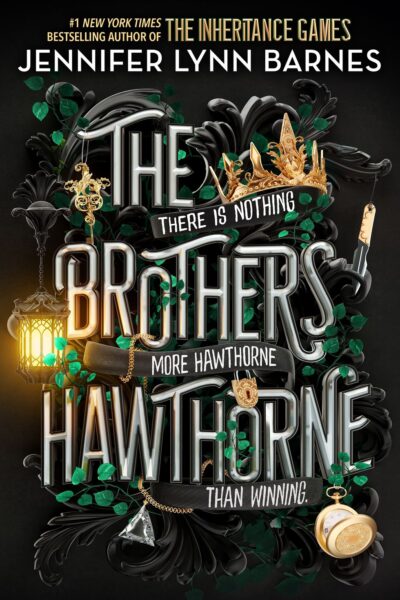
The Brothers Hawthorne
CHAPTER 83: JAMESON
by Barnes, Jennifer LynnJameson springs into action after Rohan’s cryptic hint about the key being hidden high, interpreting it as a challenge involving heights. He surveys the imposing Vantage estate, noting its castle-like structure with turrets and a towering clock tower. The setting sun casts an eerie glow on the cliffs surrounding the property, emphasizing its isolation. Realizing the bell tower is central to the clue, Jameson rushes toward it, undeterred by the treacherous drop below.
As Jameson reaches the tower, the metal gate unexpectedly rises, revealing his uncle, Simon Johnstone-Jameson. Their tense exchange reveals little, with Branford cryptically stating his role as the family head. Jameson presses for answers about Branford’s secret—his son—but receives no reply. Undaunted, he charges up the spiral staircase inside the tower, Branford close behind, both driven by the urgency of the Game.
Inside the tower, Jameson spots dozens of keys suspended near the massive bell, recognizing Rohan’s trick—only one is the real prize. Branford attempts to restrain him, warning against recklessness, but Jameson remains focused. The arrival of Zella, who lands atop the bell, heightens the stakes. Calculating the risky jump to the bell, Jameson decides to act, handing the silver chest to Branford to free his hands.
With Branford’s protests ringing in his ears, Jameson takes a daring leap toward the bell, embodying his fearless nature. The chapter ends on this cliffhanger, leaving his fate uncertain. The tension between family duty, personal ambition, and the thrill of the Game culminates in this pivotal moment, showcasing Jameson’s relentless determination to prove himself beyond the Hawthorne name.
FAQs
1. What clues lead Jameson to believe the key is hidden in the clock tower, and how does he interpret Rohan’s hints?
Answer:
Jameson deduces the key’s location through multiple clues from Rohan and his observation of Vantage’s architecture. Rohan’s statement “I sincerely hope that none of you are afraid of heights” suggests an elevated hiding spot, while his mention that the Game would begin “with the striking of the bell” directly points to the bell tower. Jameson observes the castle’s tallest structure—a square tower with a clock face and visible bell—confirming his theory. His analytical approach combines verbal cues (“fear of heights”) with contextual clues (the bell’s significance), demonstrating his pattern-solving skills characteristic of the Hawthorne family.2. How does Branford’s behavior toward Jameson evolve in this chapter, and what possible motivations drive this change?
Answer:
Branford shifts from antagonism to reluctant assistance, opening the tower door and attempting to physically restrain Jameson from danger. His stated motivation—”I’m the head of this family in every way that matters”—suggests a sense of duty, contrasting with his earlier indifference at the Devil’s Mercy. The chapter hints at deeper reasons through Jameson’s question about Branford’s “secret” (his son), implying familial obligation may override Game rivalry. Branford’s warning tone mirrors protective Hawthorne brothers (Grayson, Nash), possibly indicating conflicted loyalties between the Game’s demands and his role as de facto family patriarch.3. Analyze the significance of the key-hunting setup in the bell tower. What does this challenge reveal about Rohan’s design philosophy for the Game?
Answer:
The bell tower challenge exemplifies Rohan’s layered puzzle design. Dozens of decoy keys hung on invisible strings force competitors to discern the real challenge isn’t selection but access—the three-and-a-half-foot gap between stairs and bell. This tests both physical courage (heights, jumping) and cognitive flexibility (recognizing the keys are misdirection). The trapdoor releasing Zella adds unpredictability, showing Rohan values adaptability. By placing the puzzle near a deadly drop, he mirrors the Hawthorne family’s ethos: high-risk rewards demand absolute commitment, as emphasized by Jameson’s need to abandon the chest to attempt the jump.4. How does the chapter use Vantage’s physical setting to enhance thematic tension?
Answer:
The cliffside setting intensifies the chapter’s themes of peril and isolation. Vantage’s position on a “massive, steep, flat-topped hill nearly completely surrounded by ocean” visually represents the characters’ precarious social and emotional positions—Jameson’s literal edge-of-the-cliff climb mirrors his metaphorical brink in the family power struggle. The “brutal wind” and 70-foot drop beneath the bell tower amplify physical danger, while the single winding road to the mainland symbolizes limited escape routes from family obligations. This environmental storytelling reinforces how the Hawthornes’ world combines grandeur and threat, where every advantage (vantage point) comes with exposure to danger.
Quotes
1. “Jameson was the first one out of the room, the first one through the halls, the first one to burst out the front door and look up.”
This opening line establishes Jameson’s impulsive, competitive nature and sets the tone for the high-stakes scavenger hunt. His immediate action contrasts with others’ deliberation, showcasing his characteristic boldness.
2. “The entire estate sat on top of a massive, steep, flat-topped hill nearly completely surrounded by ocean, a world unto itself.”
This vivid description of Vantage’s geography underscores the isolation and grandeur of the setting, mirroring the Hawthorne family’s elevated status and the psychological stakes of their game.
3. “I told you before. I’m the head of this family in every way that matters. Ian might shirk his responsibilities, but I do not.”
Branford’s declaration reveals the complex family power dynamics at play. His unexpected assistance to Jameson suggests hidden motivations tied to his secret (his son) and the family’s unspoken rules.
4. “What are you without the Hawthorne name? Without the money. Without borrowing against someone else’s power. Without Avery Grambs by your side.”
This internal challenge represents the chapter’s central theme of identity and self-worth. Jameson’s recurring question drives his risky actions in the bell tower, testing his independence from family legacy.
5. “Jameson eyed the space between the staircase and the bell again. I can make it.”
This climactic moment captures Jameson’s reckless confidence and risk-taking nature. His willingness to leap across a deadly drop (after calculating the distance) epitomizes his character’s defining traits.
